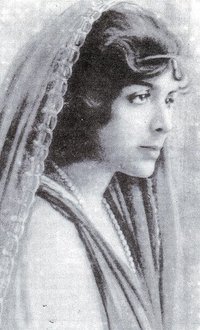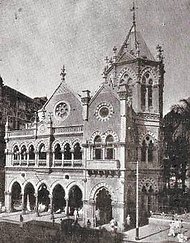Related Research Articles

Parsis or Parsees are an ethnoreligious group of the Indian subcontinent adhering to Zoroastrianism. They are descended from Persians who migrated to Medieval India during and after the Arab conquest of the Persian Empire in order to preserve their Zoroastrian identity. The Parsi people comprise the older of the Indian subcontinent's two Zoroastrian communities vis-à-vis the Iranis, whose ancestors migrated to British-ruled India from Qajar-era Iran. According to a 16th-century Parsi epic, Qissa-i Sanjan, Zoroastrian Persians continued to migrate to the Indian subcontinent from Greater Iran in between the 8th and 10th centuries, and ultimately settled in present-day Gujarat after being granted refuge by a local Hindu king.

Rattanbai Jinnah, also known as Ruttie Jinnah, was the wife of Muhammad Ali Jinnah, an important figure in the creation of Pakistan and the country's founder. Additionally, Rattanbai Petit belonged to some of the most influential families of the Indian Subcontinent, the Petit family, through her father; and the Jinnah family through her marriage. Her daughter Dina Wadia married Bombay Dyeing chairman Neville Wadia, of the Wadia family.
The Grant Government Medical College, Mumbai, is a public medical college, affiliated to the Maharashtra University of Health Sciences. Founded in 1845, it is one of the oldest institutions teaching medicine in South Asia.

South Mumbai, colloquially SoBo from South Bombay in Anglo-Indian English, administratively the Mumbai City District, is the city centre and the southernmost precinct of Greater Bombay. It extends from Colaba to Mahim and Sion neighbourhoods, and comprises the city's main business localities, making it the wealthiest urban precinct in India. Property prices in South Mumbai are by far the highest in India and among the highest in the world.

Cross Maidan is a vast expanse of land in Mumbai. The term maidan means "playing ground" in Marathi. The ground measures 23,000 m². The name "Cross" is derived for the old stone Cross (crucifix) built when the city was under Portuguese rule in the 16th century. The maidan is under the jurisdiction of the district collector. In 2009 it was announced that a 30-foot tall steel sculpture inspired by Mahatma Gandhi's charkha would be installed at the maidan. In the same year, the government also announced that it would be laying a water tunnel from the Malabar Hill reservoir to Cross Maidan at the cost of Rs. 940 million. It is claimed that the South Mumbai locality will have adequate water supply once this water tunnel is completed.

Sir Jamsetjee Jejeebhoy, 1st Baronet Jejeebhoy of Bombay, also spelt Jeejeebhoy or Jeejebhoy, was an Indian-Parsi merchant and philanthropist, later a British knight and baronet. He made a huge fortune in cotton and the opium trade with China.

Sir Dinshaw Maneckji Petit, 1st Baronet was an Indian entrepreneur and founder of the first textile mills in India, as well as a great philanthropist. He was part of the Petit family and became the first Petit baronet.
Navsari is the ninth biggest city in the state of Gujarat in India. It is the administrative headquarters of Navsari District. Navsari is situated between Surat & Mumbai. Navsari is a twin city of Surat. It is located 37 km south of Surat. As per 2011 Census of India, Navsari is 16th biggest city of Gujarat state. It ranked 10th most populous city of Gujarat in 1991 Census of India and 2001 Census of India. Navsari is the 25th cleanest city of India according to the Swachh Bharat Urban mission. Dandi village near Navsari was the focal point of the great Salt March led by Mahatma Gandhi during civil disobedience movement of India.
Neville Ness Wadia was a British businessman, philanthropist and a member of the Wadia family, an old Parsi family which, by the 1840s, was one of the leading forces in the Indian shipbuilding industry. Wadia was the last of India's aristocratic taipans, who expanded his family textile concern into one of India's largest and donated lavishly for the welfare of the Parsee community to which he belonged.
Gopalrao Deshmukh Marg is an arterial road in the city of Mumbai, India, passing through the affluent Cumballa Hill neighbourhood. The road is named after a social activist and first Mayor of Bombay after India's Independence, Dr. Gopalrao Deshmukh.

Lady Dufferin Hospital is district general hospital is located in Karachi, Sindh. Lady Dufferin Hospital to since on 1898, was named after the British peeress Lady Dufferin.

Bhulabhai Desai Road, also well known by the old name Warden Road, is a niche up-market residential and semi-commercial locality of South Mumbai.

Cumbala Hill is a hill and upmarket neighbourhood in South Mumbai flanked by the sea on the West, Altamount Road on the East, Malabar Hill on the South and Mahalaxmi on the North. The hill is at an elevation of 56 metres (184 ft).
Parsi Gymkhana is a gymkhana located along Marine Drive in Mumbai. It was built for sports and social activities of Parsis. The gymkhana is one of the founder members of the Bombay Cricket Association The club have its own cricket ground, the Parsi Gymkhana Ground, where they organise their Parsis cricket team's matches.
Jehangir Bomanji Petit was a noted nationalist, mill owner, philanthropist and one of Mahatma Gandhi's earliest supporters.
Navroji Rastomji Mistri OBE was an Parsi Indian entrepreneur and philanthropist. Known as the “godfather of the poor” or the “bachelor godfather” of Singapore’s poor children, Mistri donated a large part of his wealth towards the improvement of medical services in Singapore. He ran a successful soda drinks business in Singapore. Both Mistri Road, near Shenton Way, and Mistri Wing at the Singapore General Hospital were named in his honour.
SethBomanjee Dinshaw Petit was son of Sir Dinshaw Maneckjee Petit, Bart, and a noted cotton mill owner and philanthropist from Bombay.
SevenHills Hospital are three private hospitals, operating under central management, in Mumbai, Maharashtra and Visakhapatnam, Andhra Pradesh, India. The Vishakapatnam branch opened in 1986 and the Mumbai branch in 2010. The Mumbai hospital was the result of a Rs 10 billion public-private partnership between Seven Hills and Brihanmumbai Municipal Corporation (BMC). At 17 acres (6.9 ha) and 2,000,000 sq ft (190,000 m2) of built-up space, the Mumbai hospital was designed to be the country's largest hospital in a single location. A dedicated COVID-19 hospital was added in 2020.

The J. N. Petit Library is a membership library in a Grade II heritage structure in Fort, Mumbai. It was founded in 1898 by a group of Parsi students studying at Elphinstone College. Membership is open to residents of Mumbai.
The Bombay Parsi Punchayet is the apex body representing the Parsi Zoroastrian Community in Mumbai. BPP was founded in the 1670s. It is a charitable trust and is the city's largest private landlord controlling over 5500 houses meant for lower and middle class members of the Parsi community. It is also the Mumbai's oldest and richest charity.
References
- 1 2 3 4 "Bed, benevolence and bhonu. 100 years of Parsee General". mid-day. 9 October 2011. Retrieved 27 December 2018.
- 1 2 Naik, Yogesh. "Mumbai: Parsee General Hospital opens its doors to all communities in 105 years". Mumbai Mirror. Archived from the original on 2 October 2018. Retrieved 27 December 2018.
- ↑ "Mumbai's Parsi punchayet backs hospital for non-Parsis on Parsi land". Hindustan Times. 5 January 2018. Archived from the original on 7 January 2018. Retrieved 27 December 2018.